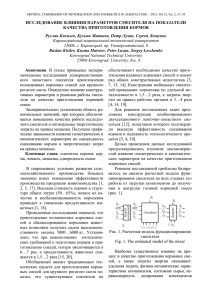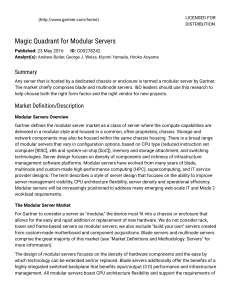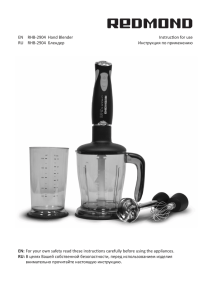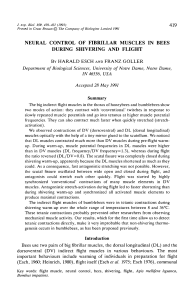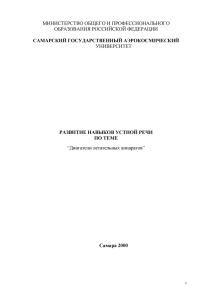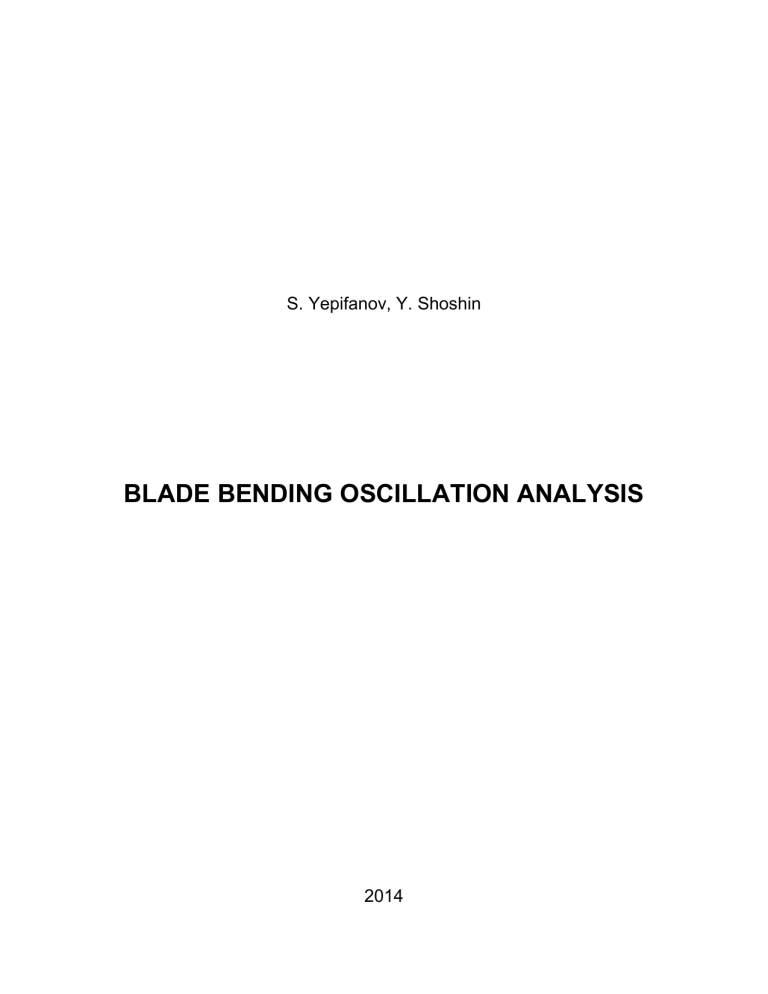
S. Yepifanov, Y. Shoshin BLADE BENDING OSCILLATION ANALYSIS 2014 MINISTRY OF EDUCATION AND SCIENCE OF UKRAINE National Aerospace University “Kharkiv Aviation Institute” S. Yepifanov, Y. Shoshin BLADE BENDING OSCILLATION ANALYSIS Tutorial Kharkov “KhAI” 2014 MINISTRY OF EDUCATION AND SCIENCE OF UKRAINE National Aerospace University “Kharkiv Aviation Institute” S. Yepifanov, Y. Shoshin BLADE BENDING OSCILLATION ANALYSIS Kharkov “KhAI” 2014 INTRODUCTION When turbine engine operates, the air flow becomes non-uniform in circumferential direction. The reason of this non-uniformity is flow disturbance by stationary vanes and struts and turbine inlet temperature non-uniformity due to finite number of fuel nozzles and burning zones in combustion chamber. Therefore parameters of flow that streamlines rotor blades are periodical, thus causing periodical gas forces acting the blades. This variation of gas forces generates blade bending oscillations. If frequency of acting force coincides with the blade natural frequency (eigenfrequency), then resonance condition will take place; the oscillation amplitude will increase that can break down the blade. To avoid dangerous resonant conditions it is necessary to change the blade natural frequency or to change the frequency of acting forces. Danger of resonance may be decreased by decreasing amplitude of oscillations due to lowering of acting forces or using special damping elements in the blade construction. Now there is no reliable method to determine the bending resonant stresses. Usually the mode shapes, natural frequencies and oscillation stresses are determined experimentally during engine development. However, there is advisable to estimate oscillation performances of rotor blades by calculations, thus avoiding crude errors. This preliminary analysis usually includes: – natural frequencies determination for some number of blade mode shapes, – dangerous harmonics estimation that initiate oscillation forces; – resonant modes (rotational speeds of the engine rotor) determination. Resonant modes are determined using the frequency diagrams. Besides, forces are estimated that decrease (dump) oscillations. There are differed bending, torsional, complex (bending and torsional) and high-frequency platelet oscillations. The bending oscillations on first shape mode are the most dangerous. Then bending oscillations on second and third mode shapes, torsion oscillations on first and second mode shapes follow. The tasks of this tutorial are to determine the blade natural frequency of first bending mode, to plot the frequency diagram and to find the engine resonant operational modes. 1 DESIGN PROCEDURE The natural bending oscillation frequency of first shape mode is determined using the Raleigh’s energy method. This method is based on the law of energy conservation in free oscillated elastic system. In compliance with this law, the total kinetic and potential energy stays constant during free oscillation of the elastic system in case the friction (damping) forces are negligible. Scheme of blade that oscillates on first bending mode is shown in Figure 1.1. The energy balance at blade oscillations is Ek E p Ac , (1.1) where E k – kinetic energy of blade in neutral position; E p – potential energy of blade deformation by internal elastic forces in extreme bended position; Ac – work of centrifugal forces on blade deformation to extreme bended position. Equation (1.1) is used to derive the formula that determines the blade natural oscillation frequency. Equations for kinetic and potential energy and for a work of centrifugal forces are considered in the lecture course on blade oscillations [1]. They are as follows: v2 4 2 2 Ek max dm f Fy 2dx ; 2 2 0 0 (1.2) L d 2y M2 1 Ep dx EJ dx ; 2 2 EJ 2 dx 0 0 (1.3) L L L L Ac edPc 0 2 L x dy dx F Rr x dx , 2 0 0 dx 2 (1.3) where x – radial coordinate of the appropriate blade section, m; dx – length of blade elementary piece; dm – mass of blade elementary piece; vmax – blade velocity in neutral position, m/s; ρ – blade density, kg/m3; f – blade oscillation frequency, Hz; F=F(x) – area of blade cross-section, m2; y=y(x) – bending flexure (transversal deformation) of blade cross-section neutral line, m; M=M(x) – bending moment in current cross-section, Nm; E=E(x) – modulus of elasticity, Pa; J=J(x) – cross-sectional moment of inertia, m4; e – maximum deformation of current cross-section aside centrifugal force, m; dPc – centrifugal force of the blade elementary piece, N; ω – rotor rotational speed, rad/s; Rr – radius of blade root cross-section, m; L – blade length, m. 1.1 Natural oscillations of non-rotated blade Let’s consider the non-rotated blade. Centrifugal forces and work of centrifugal forces Ac are zero. Thus, if the blade is located in midposition the kinetic energy will be maximum and potential energy will be zero. If it is located in extreme position kinetic energy will be zero and potential one will be maximum. Therefore maximum potential energy is equal to maximum kinetic energy. The main point of this method is to calculate the maximum value of the blade potential energy when it is located in the extreme position, and to calculate the maximum kinetic energy when it is located in a midposition. Comparing these energies the formula to calculate the frequency is obtained. For blade without a shroud 2 d 2y EJ dx 2 dx 0 0 L pn2 L . (1.4) Fy 02 ( x )dx 0 For blade with a shroud pn2 2 d 2y EJ dx 2 dx 0 0 L L , (1.5) [ Fy 02 ( x )dx Vsh y 02 sh ] 0 where pn – angular natural oscillation frequency, rad/s; Vsh – volume of shroud, m3; yo = f(x) – blade bending flexure (maximum sag) at the appropriate blade section; d 2y = f(x) – value that corresponds to blade extreme position; 2 dx 0 y0 sh = yo(xsh) – bending flexure of shroud; x0 sh – radial coordinate of shroud. To calculate the frequency using formulas (1.4) and (1.5) it is necessary to know the area of the blade’s transversal cross-section F(x), the moment of inertia J(x), the modulus of elasticity E(x) and the shape of the deflection curve y0(x) that describes the blade bending oscillation. Let’s consider that the area F and the moment of inertia J are varied according to the formulas F Fr ax m , J J r bx S , (1.6) where Fr, Jr – area and moment of inertia of the blade root section; The values J and Jr are calculated taking as reference the principal axis of minimum rigidity. It is assumed that this axis is parallel to the profile chord and passes through the gravity center of section. Coefficients a, b, m and s are determined by values of F and J at the root, mean and peripheral blade sections, which are labeled with sub-indexes “r”, “m” and “p” respectively: a Fr Fp lg m , b Jr J p Lm Fr Fp Fr Fm , s lg 2 Ls lg ; (1.7) Jr J p Jr Jm . lg 2 Let’s consider that the blade deflection curve on the first bending mode shape is represented as y O Cx q , where C – constant that can be fixed for any value (let’s set C=1); q – exponent selected from condition of minimum value of the blade first bending mode frequency. After substituting equation (1.6) into formulas (1.4) and (1.5) and doing transformations, the formulas to calculate the blade’s natural frequency may be obtained. For blade without shroud Jr J p Jr 2 2 q q 1 2q 3 2q s 3 pn2 E 2 fn , Fr Fp Fr 4 2 4 2 L4 2q 1 2q m 1 (1.8) where fn – blade natural frequency, Hz. For blade with shroud Jr J p Jr 2 2 q q 1 2q 3 2q s 3 pn2 E 2 fn . 2q Fr Fp 4 2 4 2 L4 Fr Vsh x sh 2q 1 2q m 1 L L (1.9) Calculation practice gives the range of q values: 1.6…2.5. Therefore to find actual function of the blade flexure it is necessary to calculate frequencies for different values of q in this range (usually with step of 0.1), and to draw a diagram fn f q . Figure 1.2 – Natural oscillation frequency determination According to the Raleigh’s method the lowest frequency in this diagram is the blade’s natural frequency of the first bending mode shape. Formulas (1.5) and (1.9) have been obtained for isolated blade with shroud (no considering a contact between shrouds). Real constructions are designed using continuous shrouds that are mounted with tighten joints. They need another method of calculation (this method is not considered in this tutorial). 1.2 Natural oscillations of rotated blade The important factor that influences on the blade oscillation is centrifugal force. This force tries to return the oscillating blade to a position of equilibrium, thus increasing the blade rigidity. Therefore the natural frequency of rotating blade (called dynamic frequency) fd is increased with increasing rotor rotational speed. The dynamic frequency of rotating blade under assumptions mentioned above is expressed as fd fn2 Bns2 , (1.10) where nS – rotational speed, rps; B – coefficient of proportionality depending on the blade geometry and shape of deflection curve. Coefficient B is calculated by following equations: – for blade without shroud R L q 2 Fr r Fr Fp 2q 2q 1 B F 2q 1 r 2q 1 2qR m 2q Lm 1 r Fr Fp 2q m 1 ; (1.11) – and for blade with shroud R L q Fr r Fr Fp 2 q 2 q 1 B F 2q 1 r 2q 1 2 2q Rr VshRp x sh L 2q m 2q m 1 L L . (1.12) 2q Fr Fp x sh L Vsh 2q m 1 L Equations (1.11) and (1.12) are used to calculate the coefficient B with value q qreal shown in Figure 1.2. 1.3 Frequency diagram analysis Then the frequency diagram (Bode diagram) is plot. This diagram represents natural frequency and frequencies of forcing factors in operational range of rotor rotational speed. Line of natural frequency fd=f(ns) is plot using some calculated values of dynamic frequency that are determined for some set values of rotational speed by formula (2.7). To build the frequency diagram (Figure 2.2) it is necessary to set the range of engine operational modes indicating the idle mode nidle and the maximal mode nmax. The idle mode is determined by following suppositions: – for TJE nidle = (0.3…0.35) nmax; – for TFE nidle = (0.5…0.65) nmax; – for TPE nidle = (0.8…0.9) nmax; – for TShE nidle = (0.65…0.75) nmax. Then the lines are plot that represent forcing oscillations; these lines are traced from the beginning of the coordinates. The frequency of some exciting force fe is determined as fe Kns , (1.13) where K – the number of stationary elements that produce the exiting force (that determines tangent of direct line in Figure 1.3). Figure 1.3 – Frequency diagram The most dangerous forcing factors for compressor blades are struts of front frame that support front bearing (usually K = 4…8) and also guide vanes placed before the rotor blade, which is an object of analysis; sometimes guide vanes placed after the rotor blade are considered too. The main sources of turbine blades forced oscillations are the combustion chamber (K=zFT, where zFT is the number of flame tubes or the number of fuel nozzles) and the nozzle vanes (K=zNV, where zNV is the number of nozzle vanes). The engine resonant modes are determined by values of rotational speeds that correspond to points in which the plot of natural frequency is crossed by straight lines of exciting frequencies (Figure 1.3). It is desired that resonant modes will not exist in the range of engine operation. For turbine blades (and also for blades of last compressor stages) it is necessary to take into account influence of temperature on modulus of elasticity. Due to this influence the blade temperature increases with increasing rotational speed, thus decreasing modulus of elasticity. That results in decreasing natural oscillation frequency. Since the value of coefficient B doesn’t depend on mechanical properties of material the natural frequency of turbine blades taking into account the temperature is expressed as fd fn2 ET Bns2 , E0 (1.14) where fn – natural frequency of non-rotating blade; E0, ET – modulus of elasticity at nominal and working temperature. To draw the frequency diagram of turbine blades it is enough to perform the calculations for 3-5 engine operational modes, for example nidle, 0.8nmax, 0.9nmax, nmax. The procedure to build the frequency diagram and to find the resonance modes of turbine blades is performed in the same way as for compressor blades (see Figure 1.3). 1.4 Blade temperature setting We may consider that the temperature is constant along the blade length and depends on the engine operational mode. For non-cooled blades it may be determined as [2] c2 w2 Tbl max Tm* 1 0.8 1 , 2300 2300 (1.15) where Tbl max – blade average temperature at maximum rotational speed; Tm* – flow stagnation temperature for mean radius at inlet to the rotor; c12 , w12 – absolute and relative flow velocities for mean radius at the inlet to rotor. This work has merely educational purpose, so there is no initial information about the values of gas temperature for different engine operational modes. Therefore this temperature is estimated using a plot that represents the relative gas temperature as a function of relative rotational speed. Such plot has been built using experimental data (Figure 1.4). Figure 1.4 – Variation of gas temperature with engine operational mode Figure 1.4 allows to calculate the gas temperature Tg* for different engine operation modes knowing value of gas stagnation temperature at the maximum mode Tg* max , oC. For example, according to Figure 1.4, gas stagnation temperature is equal to Tg* 0.85Tg* max for the engine operational mode n = 0.9nmax. The blade temperature changes proportionally to the gas temperature at different engine operational modes. Therefore the blade temperature can be calculated as Tbl Tbl Tg* max Tg* max . (1.16) The maximum temperature of non-cooled blade may be estimated as Tbl max (850...950)o C . Then the blade temperature for different engine modes is performed by formula (1.16). Cooled turbine blades are not considered in this tutorial. As the blade temperature is calculated, it is possible to find the value of the modulus of elasticity E for that temperature. Then the natural bending oscillation frequency for the rotating blade is calculated using formula (1.14). 2. EXECUTION ORDER The initial data for the blade oscillation analysis are: blade geometric parameters: length, area and moment of inertia at three different cross-sections (root, mean and peripheral); coordinate and volume of shroud; properties of the blade material: density and modulus of elasticity; operational range of rotational speed; gas stagnation temperature at inlet to considered stage, absolute and relative velocities of the gas flow at inlet to rotor; function that represents the blade temperature depending on rotational speed. The blade cross-sectional area and moment of inertia can be calculated with good approximation as F 0.7b ; J 0.041b h 2 2 , b – chord of blade, m; δ – maximum thickness of blade, m; h – maximum deflection (sag) of the mean line of profile, m. Formula (1.6) is used to estimate variation of cross-sectional area and moment of inertia along blade length. Once that area and moment of inertia at root, mean and peripheral crosssection are known, it is necessary to find the value of the coefficients “a”, “b”, “m” and “s” using formulas (1.7). The blade natural frequency for the first bending mode fn is calculated by formulas (1.8) or (1.9) setting ten different values for the coefficient q (from 1.6 to 2.5, with step of 0.1). It is convenient to write all results in Table 2.1. Let’s note that if blade has no shroud the row number 8 in Table 2.1 remains empty. Then the graphic that shows function fn fn (q ) is drawn (see Figure 1.2) and value q real is found that corresponds to the minimum value of the frequency fn real . where Table 2.1 – Form for manual calculation of natural frequency fn Number 1 2 q2 3 q 12 4 Jr 2q 3 Jr J p 5 6 7 Calculation results 1.6 1.7 ……………. 2.5 q 2q s 3 Fr 2q 1 Fr Fp 2q m 1 8 9 10 11 12 13 Vsh x sh L L 4 5 6 7 8 9 10 11 * 3 * 2 E 4 2 L4 14 2q fn * 12 13 The next stage in calculation is to determine the dynamic frequency of natural oscillations of the rotating blade fd by formula (1.10). Necessary value of coefficient B is calculated by formula (1.11) or (1.12) and substituted into (1.10). In these calculations q qreal (Figure 1.2). To draw the frequency diagram it is necessary to set some values of rotational speed ns (rps) at the range of 0 to nmax. In hand calculations it is enough to set only three-five values of rotational speed, for example 0.3nmax, 0.6nmax, 0.8nmax, 0.9nmax and nmax. For computer calculations it is necessary to make calculations in the interval of 0…nmax with increment of 0.1 (0.1nmax, 0.2nmax, and so on, until nmax). We n should remember that ns where n is rotational speed in rpm. 60 With the value of coefficient B and setting some values of ns we find the dynamic frequency fd using formula (1.10). It is recommendable to write all the calculations results in Table 2.2. These results are used to build the dynamic frequency as function of rotational speed fd=f(ns) (Figure 1.3). Table 2.2 – Form for manual calculation of compressor blade dynamic frequency Number Value 1 ns , rps 2 ns2 3 Bns2 4 fn2 5 fn2 Bns2 6 fd fn2 Bns2 Operational mode 1 2 3 4 5 Up to this point, calculation of the dynamic frequency for compressor and turbine blades completes. The next steps are to draw the frequency diagram, to find the resonance modes and to make the conclusions (see Figure 1.3). During calculation of the dynamic frequency of turbine blades, the influence of temperature on the blade natural (own) frequency must be considered. Formula (1.15) is used to calculate the blade temperature Tbl max at the maximum rotational speed. Then Figure 1.4 is drawn using formula (1.16) for some different engine modes, for example nidle, 0.8nmax, 0.9nmax, nmax. Once the blade temperature is known it is possible to calculate the corresponding values of the modulus of elasticity for those engine modes. Finally, the dynamic frequency for those engine modes is calculated by formula (1.14). Results of calculation are written in Table 2.3. Table 2.3 – Form for manual calculation of turbine blade dynamic frequency No Value 1 ns , rps 2 Tg* Operational mode 1 2 3 4 5 Tg* max 3 4 5 Tbl ,o C ET ET EO 6 fn2 7 fn2 8 9 10 ET EO B ns2 fn2 ET + B ns2 EO fd fn2 ET Bns2 EO The frequency diagram for turbine blade is drawn using the same method as used for compressor blades. 3. COMPUTER CALCULATION 3.1 Software structure The software DYNBLADE realizing this task consists of interface and functional program: 1) interface program serves data input and output; 2) functional program for calculation the blade dynamic frequencies at different rotational speeds. Interface program is made using Delphi tools, functional program is realized using Fortran language. The programs mentioned above communicate through one data file of digital format. Name of this file is set by User in initial dialog. First part of this file contains initial data. After first execution of the program second part is added to this file containing results. 4.2. List of identificators Parameter Modulus of elasticity Material’s density Shroud volume Radius of shroud gravity center Shroud coordinate (distance from root section) Radius of root section Blade length Blade area: root section mean section peripheral section Minimal moment of inertia of the corresponding blade section: root section mean section peripheral section Maximal rotational speed Accuracy indicator for the calculation of the dynamic frequency, accuracy of the iteration process Parameters of approximation: Designation in formulas E ρ Vsh Rsh xsh Rr L Identificator Fr Fm Fp FK FC FP Jr Jm Jp nmax ε JK JC JP NSM EPS E RO VP RP XP RK L flexure area of the transversal cross section moment of inertia of every section Dynamic frequency on the first bending shape mode 4.3 q m s fd Q M S f1 Initial data input Initial data are input in dialog mode. List of input parameters and examples are represented in Appendixes 1, 3: Appendix 1 – for compressor blade, Appendix 3 – for turbine blade. The initial data must be input using the following units: lengths, m; volume, m3; moment of inertia, m4; density, kg/m3; modulus of elasticity, MPa; rotational speed, rps (revolutions per second). 4.4 Calculation results Results are stored in file and displayed. Examples of output data are represented in Appendixes 2, 4: Appendix 2 is for compressor blade, Appendix 4 is for turbine blade. The results data sheet contains the following information: initial data according to subchapter 4.2. results of calculation are mode number, value of rotational speed, optimal value qreal, and value of the dynamic frequency. Besides of this information, the blade’s frequency diagram is also displayed. BIBLIOGRAPHY 1. Шошин, Ю.С. Расчет динамической частоты первой формы изгибных колебаний лопаток компрессоров и турбин [Текст]: учеб. пособие / Ю.С. Шошин, С.В. Епифанов, Р.Л. Зеленский. – Х.: Нац. аэрокосм. ун-т «Харьк. авиац. ин-т», 2009. – 29 с. 2. Кириченко, В.И. Прочность и колебания лопаток газотурбинных двигателей [Текст]: учеб. пособие / В.И. Кириченко. – Х.: Харьк. авиац. ин-т, 1976. – 119 с. 3. Биргер, И.А. Расчет на прочность деталей машин: справочник [Текст] / И.А. Биргер, Б.Ф. Шорр, Г.Б. Иосилевич. – М.Ж Машиностроениеб 1979. – 704 с. 4. Скубачевский, Конструкция и расчет Г.С. Авиационные деталей [Текст] газотурбинные / Г.С. двигатели. Скубачевский. – М.: Машиностроение, 1981. – 550 с. 5. Локай, В.И. Газовые турбины двигателей летательных аппаратов. Теория, конструкция и расчет [Текст] / В.И. М.К. Максутова, В.А. Стрункин. – М.: Машиностроение, 1979. – 477 с. Локай, Appendix 1 ANALYSIS OF BLADE BENDING OSCILLATIONS ON FIRST SHAPE MODE Name of executor: Engine component: Material: Jameson J., 232 gr. compressor VT-3 BLADE GEOMETRIC PARAMETERS: Blade length, m: Root radius, m: Shroud coordinate (distance from root section), m: Shroud volume, m3: Blade cross-sectional area, m2: root section: mean section: peripheral section: Minimal cross-sectional moment of inertia, m4: root section: mean section: peripheral section: PROPERTIES OF MATERIAL 3 Density, kg\m Modulus of elasticity, MPa OPERATIONAL RANGE Maximum rotational speed, rps Idle rotational speed, rps PARAMETERS OF FORCING FACTORS Number of forcing factors: Number of elements for forcing factor 1 Number of elements for forcing factor 2 0.1183 0.2013 0.0 0.0 8.87 e-5 6.65 e-5 4.435 e-5 1.18 e-10 5.24 e-11 1.721 e-11 4530 114000 205 110 2 6 57 Appendix 2 RESULTS OF CALCULATIONS Mode ns, rps qreal fd, Hz 1 2 3 4 5 6 7 8 9 10 11 0.0 20.5 41.0 61.5 82.0 102.5 123.0 143.5 164.0 184.5 205.0 1.750679 1.750679 1.750679 1.750679 1.750679 1.750418 1.750295 1.75018 1.749801 1.749801 1.748922 2642. 2643. 2645 2648 2525 2411 2419 2400 2389 2343 2213 Frequency diagram Appendix 3 ANALYSIS OF BLADE BENDING OSCILLATIONS ON FIRST SHAPE MODE Name of executor: Engine component: Material: Jameson J., 232 gr. turbine GS-6K BLADE GEOMETRIC PARAMETERS: Blade length, m: 0.043 Root radius, m: 0.214 Shroud coordinate (distance from root section), m: 0.043 3 Shroud volume, m : 3.0e-7 2 Blade cross-sectional area, m : root section: 7.38 e-5 mean section: 6.71 e-5 peripheral section: 5.95 e-5 4 Minimal cross-sectional moment of inertia, m : root section: 2.48 e-10 mean section: 2.39 e-10 peripheral section: 1.93 e-10 PROPERTIES OF MATERIAL 3 Density, kg\m 8400 Modulus of elasticity, MPa (array of 11 values at different operational modes): N 1 2 3 4 5 6 7 8 9 10 11 E 200000 200000 200000 200000 200000 188350 176700 165050 153400 141750 130100 OPERATIONAL RANGE Maximum rotational speed, rps Idle rotational speed, rps PARAMETERS OF FORCING FACTORS Number of forcing factors: Number of elements for forcing factor 1 Number of elements for forcing factor 2 205 110 2 8 43 Appendix 4 RESULTS OF CALCULATIONS Mode ns, rps qreal fd, Hz 1 2 3 4 5 6 7 8 9 10 11 0.0 20.5 41.0 61.5 82.0 102.5 123.0 143.5 164.0 184.5 205.0 1.750679 1.750679 1.750679 1.750679 1.750679 1.750418 1.750295 1.75018 1.749801 1.749801 1.748922 2642 2643 2645 2648 2525 2411 2419 2400 2389 2343 2213 Frequency diagram
